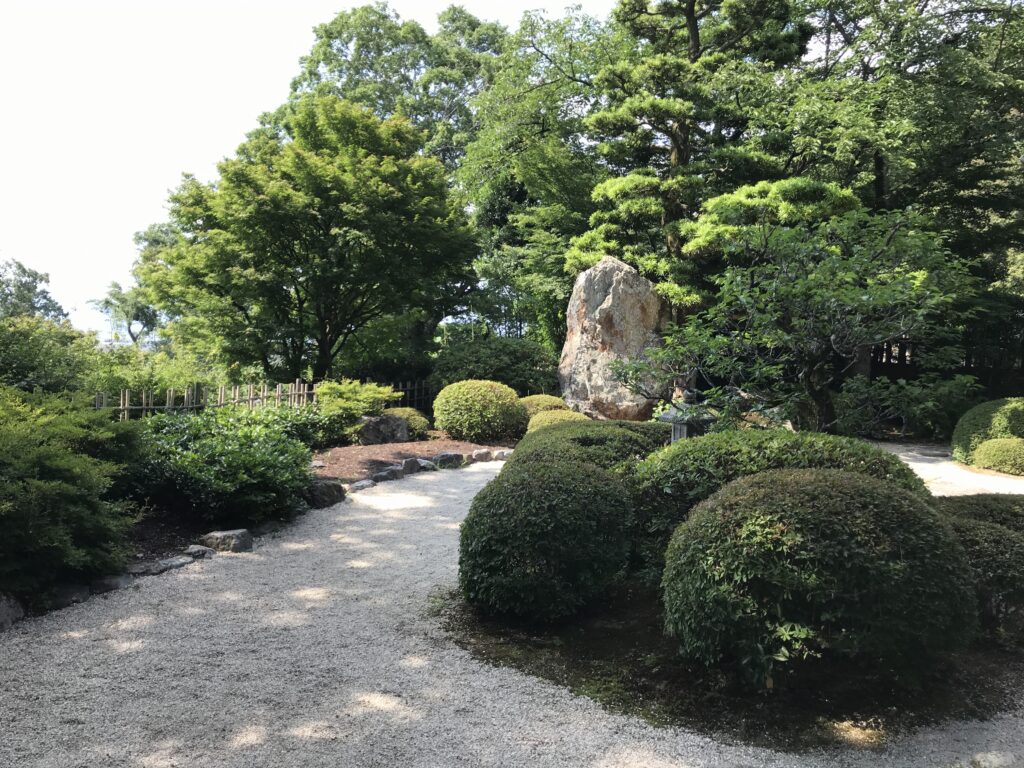黒門から入りました
次回研修生をお連れする青蓮院での事前調査を終え、そのまま南下して知恩院に向かいました。通常、国宝である日本最大の木造2重門の三門から入る方が多いと思いますが、今回は近い方の黒門から入りました。


池泉回遊式庭園を巡る
順路と反対なので、最初に方丈庭園から見て回ります。暑い日だったせいで、それほど観光客がいません。方丈の横を歩いていても、視界に入る人は一人か二人程度です。大きな庭園は池泉回遊式で、一周してみました。阿弥陀如来と25菩薩を石で表した二十五菩薩の庭は、国宝の「阿弥陀如来二十五菩薩来迎図」を基に作庭されています。



少し高い場所に登ると茶庭があり、京都市街が展望できます。ここから、道順通りに歩いたはずなのですが、墓地に出てしまいました。さすがに誰もいない場所なので、出口を探してお寺の境内に戻ってきました。


おそらく一番高台になっている場所に、法然上人の御遺骨を納めた廟堂が建っています。法然上人の銅像は、どことなく若々しく、絵巻物で見るような年老いた僧侶とは異なるイメージでした。


またまた左甚五郎が登場!
国宝の御影堂を拝んで、その屋根の下に引っ掛かっている左甚五郎が置いたといわれる、「忘れ傘」を確認しました。江戸時代の建築物や建物彫刻の伝説には必ず登場する左甚五郎が、ここにも、知恩院の七不思議の一つとして登場しています。

京都市街へ戻りがてら、境内の庭園、友禅苑も見学しました。池泉回遊式庭園と枯山水で構成されている庭園で、池の中にある台座に立つのは高村光雲作の聖観音菩薩立像です。枯山水の方まで下って、振り返ると東山を借景とした雄大な景色を楽しめます。25年近く前の独身時代に、妻と京都へ来た際に訪問した知恩院ですが、建物の中を歩いた記憶以外、全く覚えていませんでした。(完)



知恩院の御朱印


みるみるつながる仏像図鑑 流れや関係が見えるから、歴史や仏教がわかる、何より「仏像」がもっとわかる! [ 三宅 久雄 ]
価格:1,760円
(2021/9/11 11:28時点)
感想(0件)
Chion-In Temple
After completing our preliminary survey at Shorenin Temple, where we will take our next group of trainees, we headed directly south to Chion-in Temple. Normally, most people enter the temple through the Sanmon Gate, the largest double wooden gate in Japan and a National Treasure, but this time we entered through the Kuromon Gate, which is closer to the temple.
Since the route is the opposite of the order, we started from the Hojo Garden first. Because it was a hot day, there were not so many tourists. Even when walking along the side of the Hojo, there were only one or two people in sight. The large garden is a pond garden, and I circled around it. The garden of 25 Bodhisattvas, which represents Amida Nyorai and 25 Bodhisattvas with stones, was created based on the National Treasure “Raigo-zu, 25 Bodhisattvas of Amida Nyorai”.
Climbing a little higher, there is a tea ceremony garden with a view of the city of Kyoto. From here, I followed the directions but ended up in the cemetery. As expected of an empty place, I looked for a way out and returned to the temple grounds.
On what is probably the highest point of the temple grounds stands the mausoleum where Honen Shonin’s ashes are enshrined. The bronze statue of Honen Shonin looked somehow young and different from the image of an old monk we see in picture scrolls.
I worshipped at the Mikageido, a national treasure, and checked the “forgotten umbrella,” said to have been placed there by Jingoro Hidari, hanging under the roof. The legend of Hidari Jingoro, who always appears in the legends of Edo period architecture and building sculptures, also appears here as one of the Seven Wonders of Chion-in Temple.
On our way back to downtown Kyoto, we also visited the Yuzen Garden, a garden on the grounds of the temple. The garden consists of a pond garden and a karesansui (dry landscape garden), and standing on a pedestal in the pond is a standing statue of Saint Kannon by Takamura Koun. I had visited Chion-in Temple when I was a bachelor with my wife in Kyoto almost 25 years ago, but I had no memory of it except for walking around the building. (End)

新品価格
¥2,420から
(2022/5/6 23:06時点)
Le temple de Chion-in
Après avoir terminé notre enquête préliminaire au temple Shorenin, où nous emmènerons notre prochain groupe de stagiaires, nous nous sommes dirigés directement vers le sud, au temple Chion-in. Normalement, la plupart des gens entrent dans le temple par la porte Sanmon, la plus grande porte double en bois du Japon et un trésor national, mais cette fois, nous sommes entrés par la porte Kuromon, qui est plus proche du temple.
Comme l’itinéraire est l’inverse de l’ordre, nous avons commencé par le jardin Hojo. Comme c’était une journée chaude, il n’y avait pas beaucoup de touristes. Même en marchant sur le côté du Hojo, il n’y avait qu’une ou deux personnes en vue. Le grand jardin est un jardin d’étang, et j’en ai fait le tour. Le jardin des 25 Bodhisattvas, qui représente Amida Nyorai et 25 Bodhisattvas avec des pierres, a été créé d’après le trésor national “Raigo-zu, 25 Bodhisattvas d’Amida Nyorai”.
En montant un peu plus haut, on trouve un jardin de cérémonie du thé avec une vue sur la ville de Kyoto. De là, j’ai suivi les indications mais je me suis retrouvé dans le cimetière. Comme je m’y attendais dans un endroit vide, j’ai cherché une sortie et suis retourné dans l’enceinte du temple.
Sur ce qui est probablement le point le plus élevé du temple se trouve le mausolée où les cendres de Honen Shonin sont enterrées. La statue en bronze de Honen Shonin avait l’air jeune et différente de l’image d’un vieux moine que l’on voit sur les rouleaux de photos.
Je me suis recueilli au Mikageido, un trésor national, et j’ai vérifié le “parapluie oublié”, qui aurait été placé là par Jingoro Hidari, accroché sous le toit. La légende de Jingoro Hidari, qui apparaît toujours dans les légendes de l’architecture et des sculptures des bâtiments de la période Edo, apparaît également ici comme l’une des sept merveilles du temple Chion-in.
Sur le chemin du retour vers le centre-ville de Kyoto, nous avons également visité le jardin Yuzen, un jardin situé sur le terrain du temple. Le jardin se compose d’un jardin d’étang et d’un karesansui (jardin paysager sec), et sur un piédestal dans l’étang se trouve une statue debout de Sainte Kannon par Takamura Koun. J’avais visité le temple Chion-in lorsque j’étais célibataire avec ma femme à Kyoto, il y a presque 25 ans, mais je n’en avais aucun souvenir, si ce n’est de m’être promené dans le bâtiment. (Fin)
